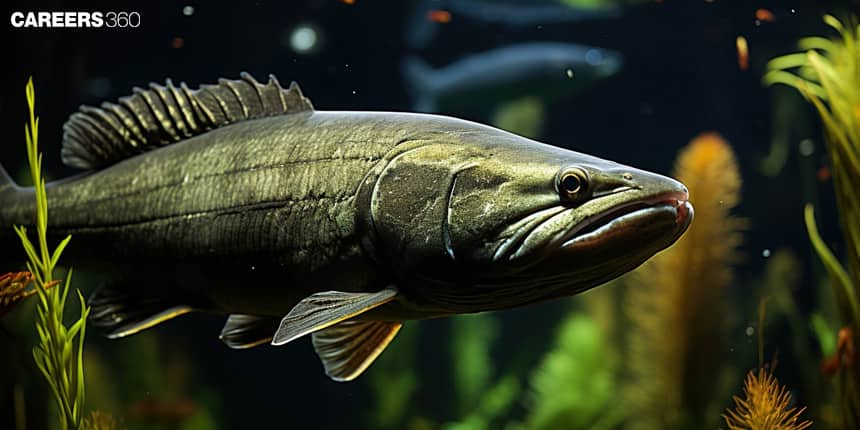Osteichthyes: Definition, Classification, Characteristics, Examples, Facts
Definition Of Osteichthyes
Osteichthyes are a class of vertebrates differentiated by bony skeletons, not cartilage. This is the largest class of vertebrates, with about over 30,000 species. The main characteristics are the presence of a skeletal endoskeleton, gill covers or operculum, and in most cases, paired fins. All types of fishes, as well as recent tetrapods, are of common ancestry and thus display the typical vertebrate body plan. They are also crucial models for physiological research, especially in respiration physiology, osmoregulation, and sensory adaptation.
NEET 2025: Mock Test Series | Syllabus | High Scoring Topics | PYQs
NEET Important PYQ's Subject wise: Physics | Chemistry | Biology
New: Meet Careers360 B.Tech/NEET Experts in your City | Book your Seat now

Classification Of Osteichthyes
Osteichthyes constitute a part of the kingdom Animalia, phylum Chordata, and subphylum Vertebrata, which means that at some stage in their life, they have a backbone and notochord.
Class: Osteichthyes
This class is further divided into two major groups.
Actinopterygii: Ray-finned fish, fins supported by bony rays.
Sarcopterygii: Lobe-finned fish, also called fleshy, lobed fins that are limb-like in structure.
Major Groups within Osteichthyes
Actinopterygii: Very many species of fish, including trout, perch, and tuna; fins supported by thin, bony rays.
Sarcopterygii: Coelacanths and lungfishes; branch into muscular fins that are almost limb-like in appearance—suggesting a closer evolutionary relationship with tetrapods.
Morphology And Anatomy Of Osteichthyes
The body shapes of Osteichthyes range from streamlined forms in fast swimmers to flattened shapes in bottom dwellers.
Different types of scales, ctenoid and cycloid, protect and reduce friction against the passage of water.
Their fins—all dorsal, pectoral, pelvic, anal, and caudal—are each specialised to perform different stabilisation, manoeuvring, and propulsion functions.
It is powered through an endoskeleton, which consists mostly of bone, used for protection and structural support of internal organs.
This also features specialised muscles that enable efficient swimming, whether in red muscle used for sustained swimming or white muscle that provides the burst movements.
It has a mouth, oesophagus, stomach, and intestine in the digestive system for digestion.
The organism respires through the removal of oxygen from water using gills and gives out carbon dioxide, which is the byproduct formed during cellular respiration.
The circulatory system is a closed-loophole system with a two-chambered heart that ensures the proper functioning of the body processes by delivering oxygenated blood throughout the body.
Recommended Video for Osteichthyes
Life Cycle of Osteichthyes
Actinopterygii often practices external fertilization, where eggs and sperm are released into water.
Sarcopterygii generally exhibit internal fertilization, with the transfer of sperm directly into the female's body.
Eggs are laid in water, with protective coatings to prevent desiccation.
Larvae undergo metamorphosis into juvenile fish, adapting to their specific ecological niche.
Adaptations And Physiology Of Osteichthyes
In the majority of Actinopterygii cases, there is external fertilisation whereby eggs and sperm are released in water.
Sarcopterygii, correlated in general with internal fertilisation, involves the transfer of sperm directly into the female's body.
Eggs are laid in water; with protective coatings to prevent desiccation.
Later, the larvae develop into juvenile fish and mature into adults to occupy their respective ecological niches.
Behaviour And Ecology Of Osteichthyes
Adaptations to varying aquatic environment conditions in relationship to changing salinity levels, temperature ranges, and disparate oxygen concentrations.
Diets range diversely from plankton and algae to larger prey with specialized dentition and feeding mechanisms.
Migrating to spawn per seasonal variations of temperature, water flow, and food availability.
Economic Importance
The major source of protein and income in coastal communities across the globe, hence contributing to food security.
Conditioning of fish species under controlled environments to satisfy global demand without sacrificing the environment.
Conservation And Environmental Impact On Osteichthyes
The Osteichthyes, or the bony fish, are under great threat from overfishing, habitat destruction, and pollution, all contributing to the decline in fish populations and loss of biodiversity in aquatic ecosystems. Such pressures disrupt the ecological balance that impacts not only fish species but the larger environments in which they live, both in the marine and freshwater environments.
These threats are met with different conservation efforts. For example, fishing quotas, marine reserves, and other sustainable ways of catching fish do exist. In the same way, habitat restorations render damaged ecosystems safe again. Therefore, fish stocks and habitats are conserved and restored for the future.
Conclusion
It is then related to the main distinctive features in anatomical and physiological contexts that reflect on Osteichthyes, the bony fish, such as various body shapes, specialised fins, and efficient respiratory and circulatory systems. These characteristics are at the core of helping them live and multiply in various aquatic environments. In turn, their ecological functions are critical for sustaining biodiversity and health in ecosystems.
Frequently Asked Questions (FAQs)
Osteichthyes, otherwise known as bony fish, are characterized mainly by the skeleton being composed of bone; with specialized fins for manoeuvring and a diversity of scales that provide protection and lubricate movement through the water.
Bony fish will normally reproduce by external fertilization, where eggs and sperm are released into the water, but some species do show internal fertilization.
These swimming adaptations could include things such as streamlined body shapes for effective locomotion, specialized muscles for various swimming speeds, and fins for stabilization, manoeuvrability, and propulsion.
Bony fish maintain buoyancy with the help of their swim bladder, an internal organ filled with gas bubble pairs. This allows the fish to stabilize at the chosen depth in the water without expenditure of any energy.
Bony fish are a major source of protein for humans and are essential to global fisheries and aquaculture industries, contributing significantly to food security and economies.
Also Read
29 Nov'24 12:52 PM
26 Nov'24 04:23 PM
26 Nov'24 04:19 PM